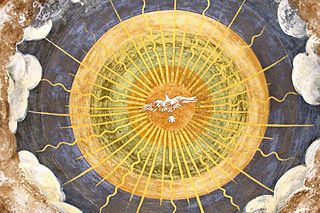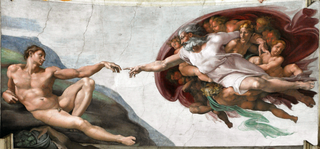In linguistics, a grammatical gender system is a specific form of a noun class system, where nouns are assigned to gender categories that are often not related to the real-world qualities of the entities denoted by those nouns. In languages with grammatical gender, most or all nouns inherently carry one value of the grammatical category called gender; the values present in a given language are called the genders of that language.
In Judaism, the Holy Spirit, otherwise known as the Holy Ghost, is the divine force, quality and influence of God over the universe or his creatures. In Nicene Christianity, the Holy Spirit is the third person of the Trinity. In Islam, the Holy Spirit acts as an agent of divine action or communication. In the Baha’i Faith, the Holy Spirit is seen as the intermediary between God and man and "the outpouring grace of God and the effulgent rays that emanate from His Manifestation".
Many Wikipedia articles on religious topics are not yet listed on this page. If you cannot find the topic you are interested in on this page, it still may already exist; you can try to find it using the "Search" box. If you find that it exists, you can edit this page to add a link to it.
Nontrinitarianism is a form of Christianity that rejects the mainstream Christian theology of the Trinity—the belief that God is three distinct hypostases or persons who are coeternal, coequal, and indivisibly united in one being, or essence. Certain religious groups that emerged during the Protestant Reformation have historically been known as antitrinitarian.

Elohim, the plural of אֱלוֹהַּ, is a Hebrew word meaning "gods" or "godhood". Although the word is grammatically plural, in the Hebrew Bible it most often takes singular verbal or pronominal agreement and refers to a single deity, particularly the God of Israel. In other verses it refers to the singular gods of other nations or to deities in the plural.

Pneumatology refers to a particular discipline within Christian theology that focuses on the study of the Holy Spirit. The term is derived from the Greek word Pneuma, which designates "breath" or "spirit" and metaphorically describes a non-material being or influence. The English term pneumatology comes from two Greek words: πνεῦμα and λόγος. Pneumatology includes study of the person of the Holy Spirit, and the works of the Holy Spirit. This latter category also includes Christian teachings on new birth, spiritual gifts (charismata), Spirit-baptism, sanctification, the inspiration of prophets, and the indwelling of the Holy Trinity. Different Christian denominations have different theological approaches on various pneumatological questions.

The Gospel of the Hebrews, or Gospel according to the Hebrews, is a lost Jewish–Christian gospel. The text of the gospel is lost, with only fragments of it surviving as brief quotations by the early Church Fathers and in apocryphal writings. The fragments contain traditions of Jesus' pre-existence, incarnation, baptism, and probably of his temptation, along with some of his sayings. Distinctive features include a Christology characterized by the belief that the Holy Spirit is Jesus' Divine Mother and a first resurrection appearance to James, the brother of Jesus, showing a high regard for James as the leader of the Jewish Christian church in Jerusalem. It was probably composed in Greek in the first decades of the 2nd century, and is believed to have been used by Greek-speaking Jewish Christians in Egypt during that century.
In philosophy and religion, spirit is the vital principle or animating essence within humans or, in some views, all living things. Although views of spirit vary between different belief systems, when spirit is contrasted with the soul, the former is often seen as a basic natural force, principle or substance, whereas the latter is used to described the organized structure of an individual being's consciousness, in humans including their personality. Spirit as a substance may also be contrasted with matter, where it is usually seen as more subtle, an idea put forth for example in the Principia Mathematica.
The gender of God can be viewed as a literal or as an allegorical aspect of a deity.
Christian feminism is a school of Christian theology which uses the viewpoint of a Christian to promote and understand morally, socially, and spiritually the equality of men and women. Christian theologians argue that contributions by women and acknowledging women's value are necessary for a complete understanding of Christianity. Christian feminists are driven by the belief that God does not discriminate on the basis of biologically-determined characteristics such as sex and race, but created all humans to exist in harmony and equality regardless of those factors. On the other hand, Christian egalitarianism is used for those advocating gender equality and equity among Christians but do not wish to associate themselves with the feminist movement.
In Christian theology, the tripartite view (trichotomy) holds that humankind is a composite of three distinct components: body, spirit, and soul. It is in contrast to the bipartite view (dichotomy), where soul and spirit are taken as different terms for the same entity.

Gender neutrality in languages with grammatical gender is the usage of wording that is balanced in its treatment of the genders in a non-grammatical sense. For example, advocates of gender-neutral language challenge the traditional use of masculine nouns and pronouns when referring to two or more genders or to a person of an unknown gender in most Indo-European and Afro-Asiatic languages. This stance is often inspired by feminist ideas about gender equality. Gender neutrality is also used colloquially when one wishes to be inclusive of people who identify as non-binary genders or as genderless.

A system of grammatical gender, whereby every noun was treated as either masculine, feminine, or neuter, existed in Old English, but fell out of use during the Middle English period; therefore, Modern English largely does not have grammatical gender. Modern English lacks grammatical gender in the sense of all noun classes requiring masculine, feminine, or neuter inflection or agreement; however, it does retain features relating to natural gender with particular nouns and pronouns to refer specifically to persons or animals of one or other sexes and neuter pronouns for sexless objects. Also, in some cases, feminine pronouns are used by some speakers when referring to ships, to churches, and to nation states and islands.
This is a glossary of terms used in Christianity.
In Judaism, the Holy Spirit refers to the divine force, quality, and influence of God over the universe or over God's creatures, in given contexts.

God in Christianity is represented by the Trinity of three hypostases or "persons" described as Father, Son and Holy Spirit. While "Father" and "Son" implicitly invoke masculine sex, the gender of the Holy Spirit from earliest times was also represented as including feminine aspects. Today, there is a push among some Christians for use of different pronouns to describe God than have been traditionally held.
Ugaritic is an extinct Northwest Semitic language. This article describes the grammar of the Ugaritic language. For more information regarding the Ugaritic language in general, see Ugaritic language.

In Spanish, grammatical gender is a linguistic feature that affects different types of words and how they agree with each other. It applies to nouns, adjectives, determiners, and pronouns. Every Spanish noun has a specific gender, either masculine or feminine, in the context of a sentence. Generally, nouns referring to males or male animals are masculine, while those referring to females are feminine. In terms of importance, the masculine gender is the default or unmarked, while the feminine gender is marked or distinct.
Nephesh is a Biblical Hebrew word which occurs in the Hebrew Bible. The word refers to the aspects of sentience, and human beings and other animals are both described as being nephesh. Bugs and plants, as examples of live organisms, are not referred in the Bible as being nephesh. The primary meaning of the term נפש is 'the breath of life' instinct in the nostrils of all living beings, and by extension 'life', 'person' or 'very self'. There is no term in English corresponding to nephesh, and the (Christian) 'soul', which has quite different connotations is nonetheless customarily used to translate it. One view is that nephesh relates to sentient being without the idea of life and that, rather than having a nephesh, a sentient creation of God is a nephesh. In Genesis 2:7, the text is not that Adam was given a nephesh but that Adam "became a living nephesh." Nephesh when put with another word can detail aspects related to the concept of nephesh; with רוּחַ rûach it describes a part of mankind that is immaterial, like one's mind, emotions, will, intellect, personality, and conscience, as in Job 7:11.

For the majority of Christian denominations, the Holy Spirit, or Holy Ghost, is believed to be the third Person of the Trinity, a triune God manifested as God the Father, God the Son, and God the Holy Spirit, each being God. Nontrinitarian Christians, who reject the doctrine of the Trinity, differ significantly from mainstream Christianity in their beliefs about the Holy Spirit. In Christian theology, pneumatology is the study of the Holy Spirit. Due to Christianity's historical relationship with Judaism, theologians often identify the Holy Spirit with the concept of the Ruach Hakodesh in Jewish scripture, on the theory that Jesus was expanding upon these Jewish concepts. Similar names, and ideas, include the Ruach Elohim, Ruach YHWH, and the Ruach Hakodesh. In the New Testament the Holy Spirit is identified with the Spirit of Christ, the Spirit of Truth, and the Paraclete (helper).







